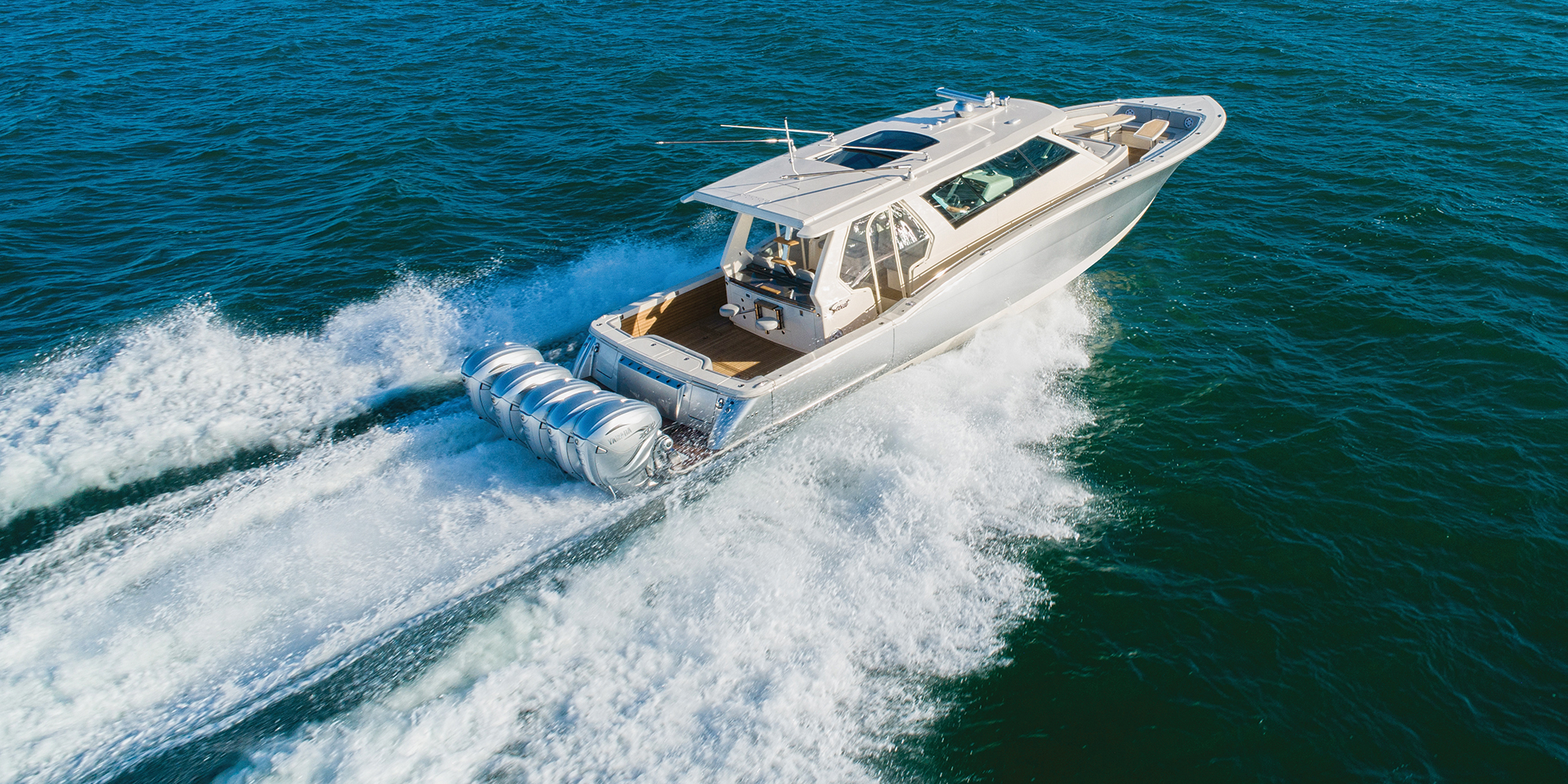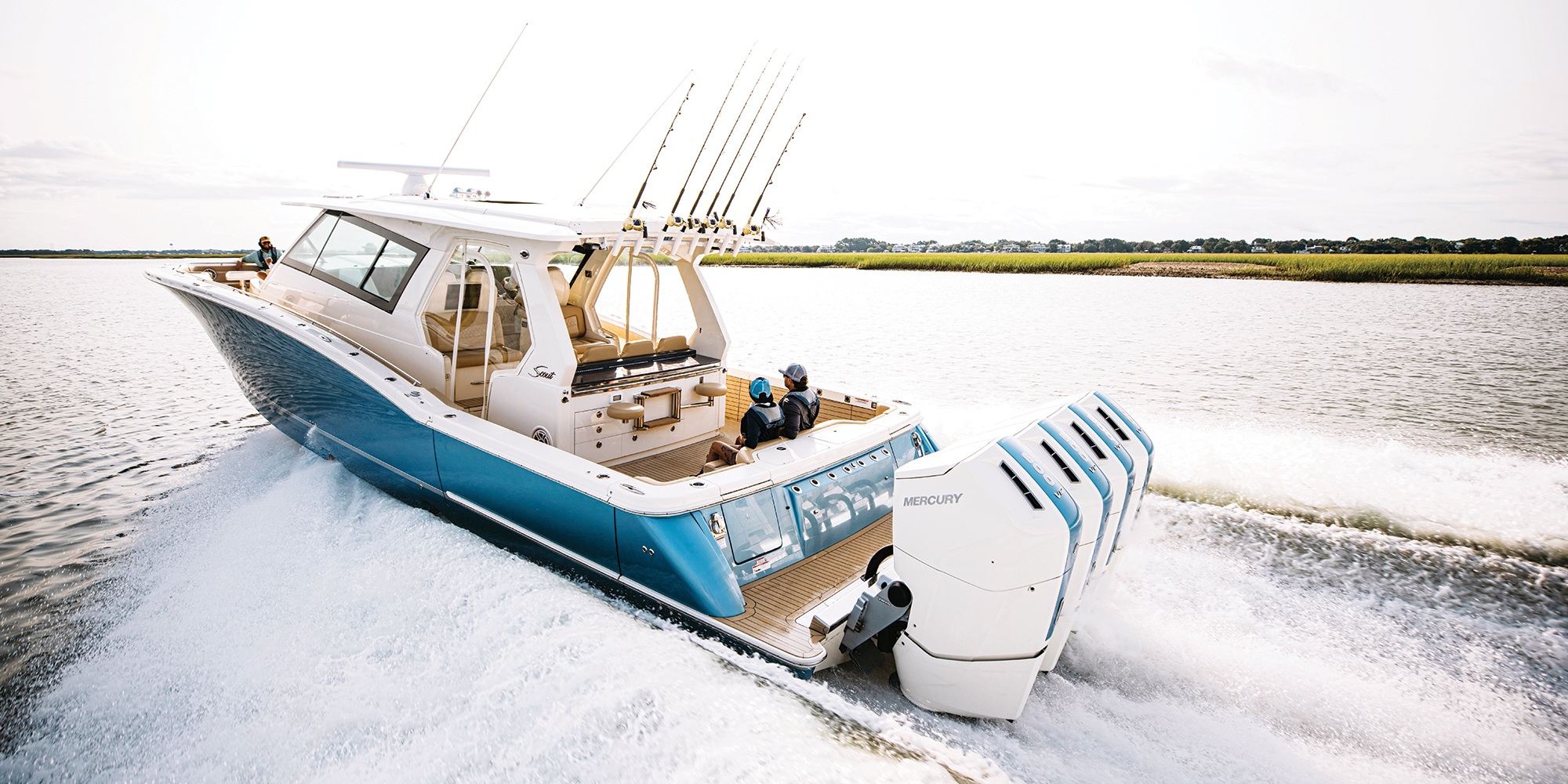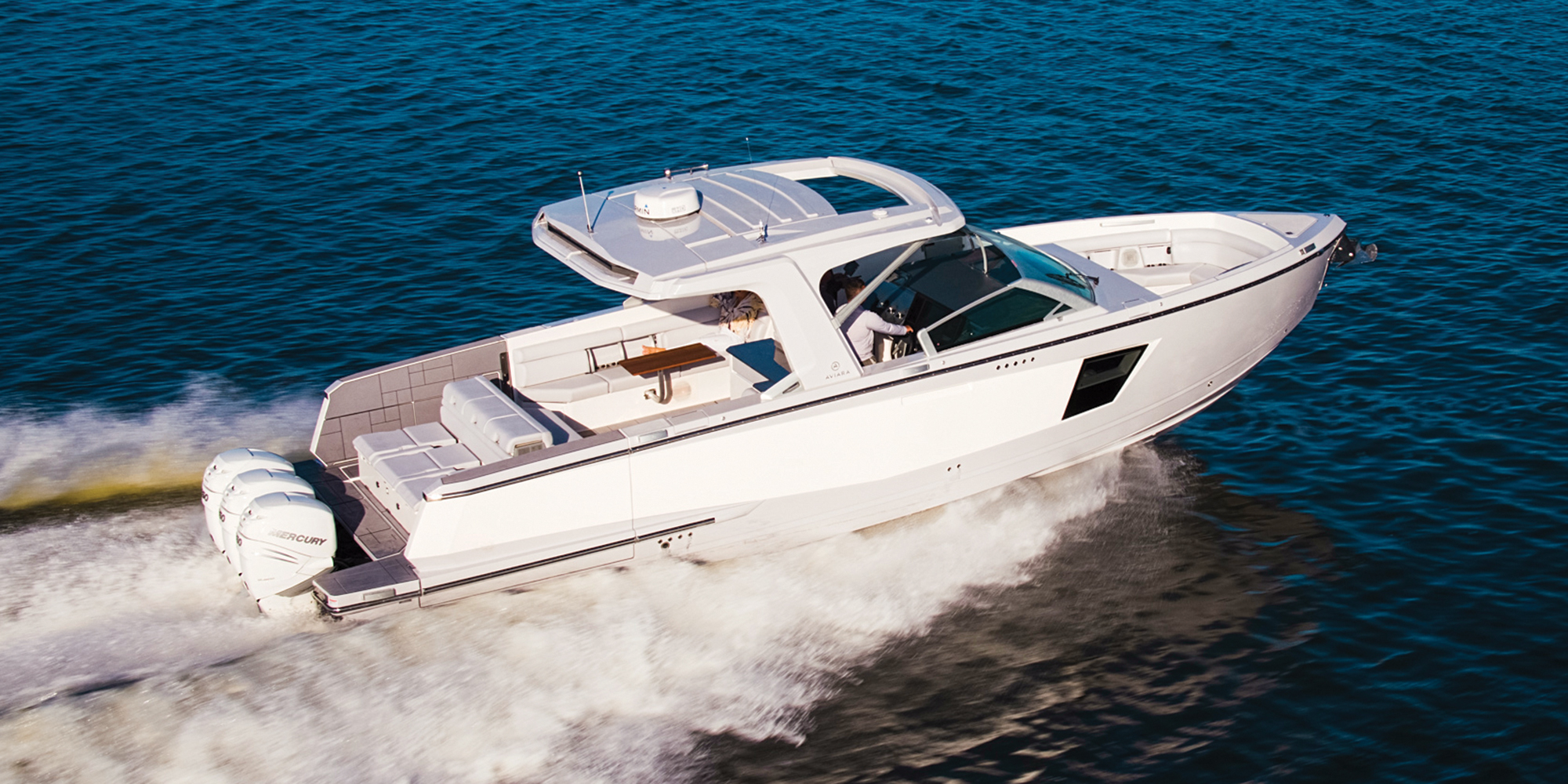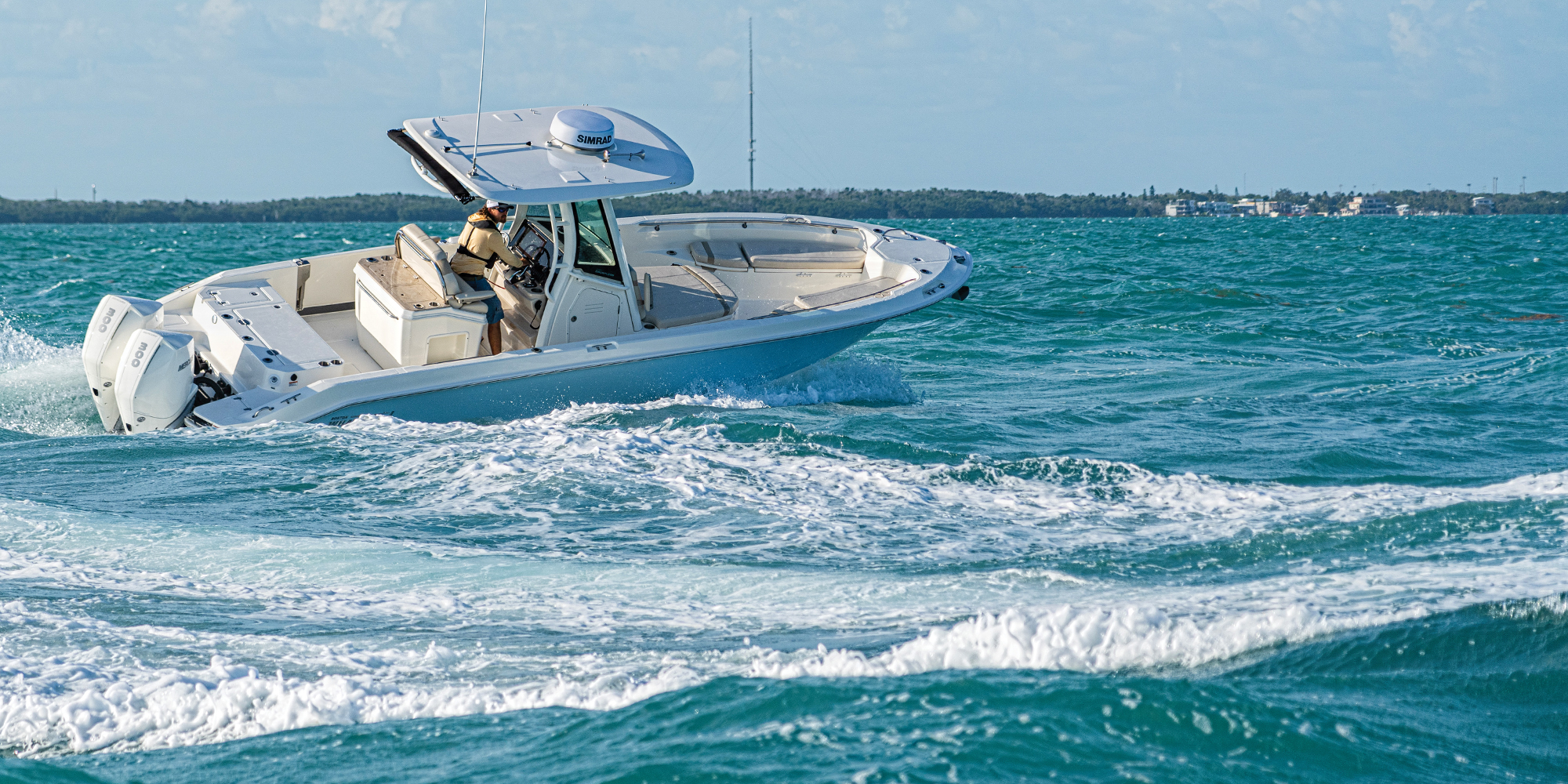The outboard motor can be traced directly to a bowl of ice cream. As the story goes, a clever young machinist named Ole Evinrude had rowed his girlfriend, Bessie, to a Wisconsin island for a picnic when she wanted a dish of ice cream. Being both dutiful and enamored, he rowed the 2 miles back. But by the time he returned to his bride-to-be, the ice cream had melted (and he was exhausted). Evinrude swore there had to be a better way and promptly created a one cylinder 1.5-horsepower outboard motor that clamped onto his rowboat. Thus was born the first Evinrude outboard in 1907 and the name, along with others, went on to grace the sterns of boats from our childhoods.
Today, you can walk into any boat dealership and buy a 450-horsepower outboard. More than likely, however, you might order a boat with as many as six of these behemoths on the stern.
What’s led to this rage for outboards? For starters, the center console boat has become popular.
MarineMax St. Petersburg general manager Joshua Lavine says, “Center console boats have become a staple of many people’s boating adventures for the same reasons as SUVs: versatile layouts, comfort and flexibility.”
Plus, these are perfectly suited to outboard power. Before you condemn outboards, however, the days of shaky, smokey and loud outboards are long gone. Today, they’re quiet, smooth, powerful and fuel-efficient. And, when it comes to maintenance, they’re designed for salt water and are easily serviced.
 There was a time not too long ago when the rumble of exhausts from sterndrive or inboard boats was the clear symbol of power, just like the same sound from a hotrod revving up on land. Now you only need to count the outboards hanging on the stern to see the machismo of the owner.
There was a time not too long ago when the rumble of exhausts from sterndrive or inboard boats was the clear symbol of power, just like the same sound from a hotrod revving up on land. Now you only need to count the outboards hanging on the stern to see the machismo of the owner.
Just as there was a horsepower race among car companies, the builders of outboards have also been one-upping each other with more powerful engines every year. The current leader of the pack is Mercury, with its 600-horsepower Verado 7.6 liter. This is a V-12 (think Ferrari or Lamborghini) with an industry-first, two-speed transmission.
Seven Marine was created in 2010 to produce an outboard version of the asphalt-shredding General Motors 6.2-liter 627-horsepower supercharged V-8 from ZL1 Chevy Camaros, but the company was purchased in 2020 by Volvo-Penta, a major marine power producer, and folded to meet their low-emissions standards.
That leaves Mercury at the top of the power pile, but Mercury and Yamaha have been slugging out the horses race for years, bringing out 350-, then 400- and then 450-horsepower engines. Suzuki startled the outboard world in 2021 with a V-6 twin-propeller, 350-horsepower offering that they claimed would get a better “bite” on the water, while Honda stayed in the running with a 250-horsepower engine.
But why have outboards proliferated? Here are six reasons to consider, listed in no particular order.
First is the versatility. With outboards, a boat has less draft so it can run up on a sandbar for a family outing simply by tilting the engines up.
Performance and reliability is a second reason and outboards have enjoyed great technical advances in the last two decades. Four-stroke systems and direct fuel injection make them simpler to service. And anyone operating a sterndrive in salt water knows the constant vigilance required to prevent corrosion between the aluminum drive and water, while the outboard can easily be tilted above the water.
Yes, outboards are saltwater-cooled, but their systems make regular flushing easy with dockside hoses. It’s not a problem in Florida, but winterizing an outboard is considerably simpler than having to drain and protect inboard engines from winter cold.
In addition, both sterndrive and inboard boat owners know that working on engines, buried in the bilge and inaccessible, is time- and cost-intensive for service. With the outboard, the shell around the powerhead is easily removed and, for major work, the engine can be taken to a shop. Even replacing the entire engine is simpler with an outboard: unbolt one, bolt on another. Easy-peasy.
A further outboard benefit is fewer holes in the hull from prop shafts and struts, and far fewer leaks. And having two engines on the stern creates a get-home redundancy not found in single-engined boats.
A third property of outboards is their modern technology, with digital throttles and shifters, which make even novices look good when docking or maneuvering.
There is never enough space on a boat, but removing the power from inside the boat opens the cockpit for family fun. With no engine box or boxes covering the engines, there can be a flat floor from the helm all the way to the stern.
Yes, outboards eliminate a transom swim platform but, on a boat like the Boston Whaler 280 Dauntless center console, this has been replaced with a fold-down “beach” on one side, providing easy water access with its own ladder. In addition, the area under the cockpit offers spacious storage for fenders, fishing gear or water toys.
 Last, but far from least, is fuel economy. Not having to take out a mortgage to spend a day on the water makes family outings fun again, and modern outboards are both lighter and more powerful. Aside from showing off, outboards are also more fuel-efficient than other power plants, and hanging twin, triple or quad outboards allows today’s boats to cruise at higher speeds with lower fuel consumption.
Last, but far from least, is fuel economy. Not having to take out a mortgage to spend a day on the water makes family outings fun again, and modern outboards are both lighter and more powerful. Aside from showing off, outboards are also more fuel-efficient than other power plants, and hanging twin, triple or quad outboards allows today’s boats to cruise at higher speeds with lower fuel consumption.
Why so many outboards on one boat? Said one owner, “Because I can.” Hard to argue. But it’s still startling, shocking or exciting (depending on your boating preferences) to see the world’s largest center console, the HCB 65-footer Estrella with six — count ‘em — six Mercury Racing 600-horsepower outboards clamped to the transom. With 3,600 horsepower under your fist, the Estrella will easily top 70 miles per hour.
“And,” says Kevin Cook at Ultimate Marine, the Tampa area dealer, “you’re moving a luxuriously appointed hotel suite too.”
In addition to cockpit theater seating, the Estrella has two air-conditioned cabins twice as large as other center console boats, plus a full galley and a head with a stall shower, making it the perfect weekender.
Another “big gun” is the Scout 530 LXF, which strings six Merc 400s across its 14-foot, 8-inch transom. Combining power (2,400 horsepower) with both fishability (is that a word?) and luxury, the 530 will push avid anglers into the 75-mile-per-hour range.
But not everyone wants an outboard-powered boat for speed. When it comes to repowering your boat, which is something every boat owner dreads, Marine Max’s Lavine notes, “Outboards can more easily be repowered than any other engine option. Compare that to marrying your boat to a more permanent inboard engine(s) that you’ll never reasonably want to consider trying to remove or upgrade.”
Other “hidden” benefits to outboards is that every manufacturer, boat and engine, offers personalization so you can match your outboards to your hull color or, on the other hand, pick a color you like (pink? black?).
Whatever the reasons, it’s clear that outboards—and multi-outboards—are here to stay. They once were called “kickers,” but you can now run down to get a dish of ice cream without a worry about meltdown.
Chris Caswell is an award-winning writer and the former editor of several yachting magazines. He has appeared on Oprah as a boating lifestyle expert and hosted the Marine Voyager series on the Speed Channel.



